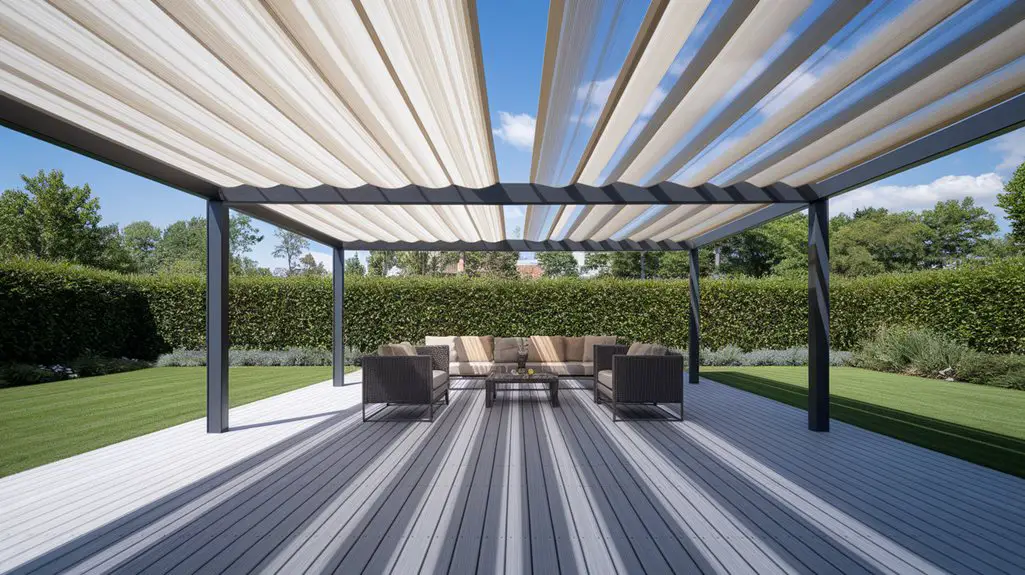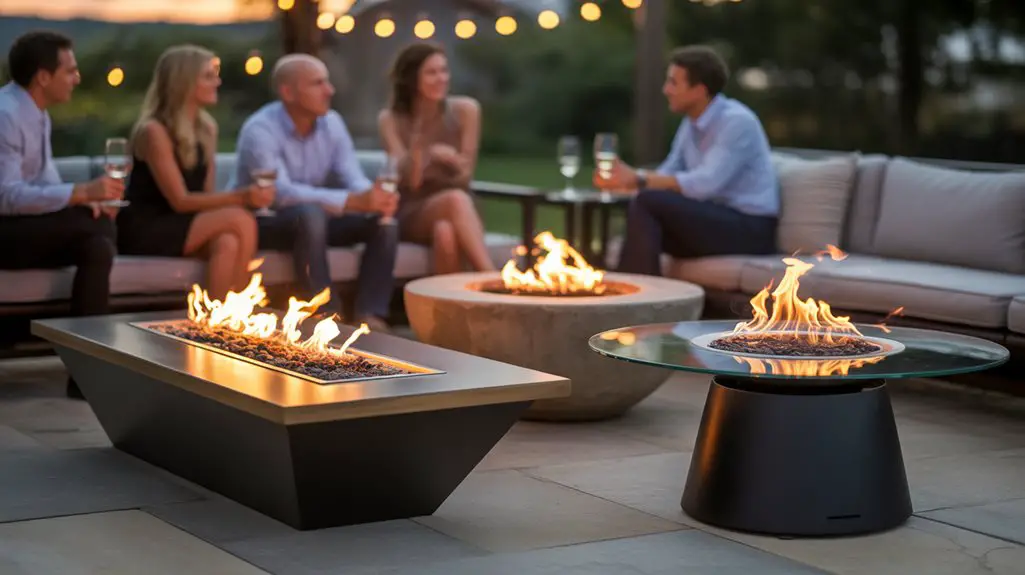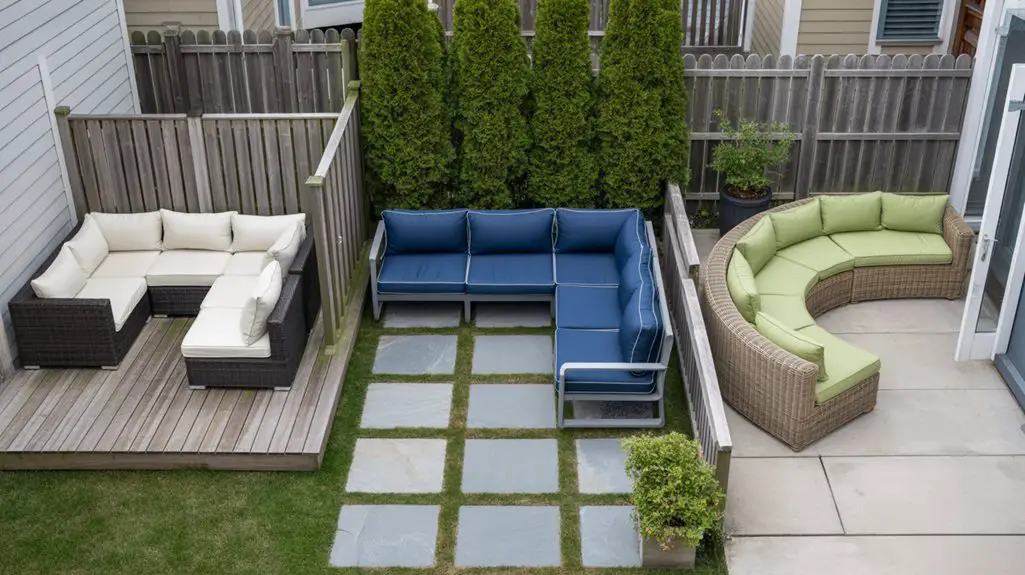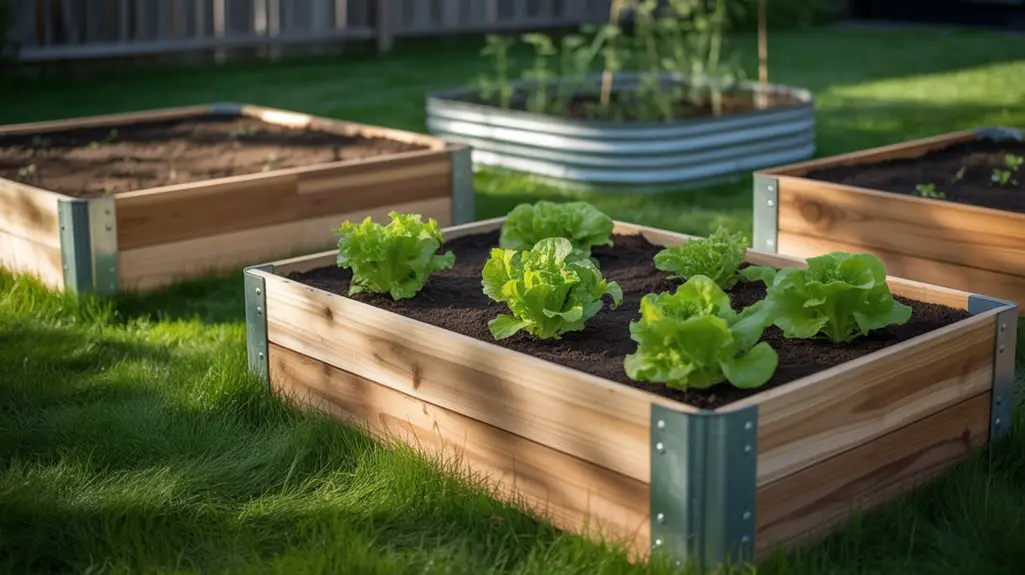Your outdoor living space deserves protection that won’t surrender to nature’s whims. When selecting weather-resistant patio shades, you’ll need to balance durability against style, considering how local climate conditions will test your investment daily. UV rays fade fabrics, winds stress mounting hardware, and rain challenges waterproofing claims. The right shade solution transforms your patio from occasionally usable to consistently comfortable, regardless of what the forecast predicts. But which materials and designs truly deliver on their all-weather promises?
Types of Weather-Resistant Materials for Patio Shades
Durability stands as the cornerstone of any weather-resistant patio shade. When selecting materials, consider Sunbrella fabrics—engineered to resist UV rays, mildew, and water damage while maintaining vibrant colors year after year.
Solution-dyed acrylics offer similar protection with breathable qualities that prevent heat buildup underneath.
For more structural options, powder-coated aluminum frames won’t rust or corrode when faced with rain and humidity. They’re lightweight yet sturdy enough to withstand moderate winds.
High-density polyethylene (HDPE) provides exceptional resilience against harsh elements without warping or fading.
Marine-grade vinyl combines waterproof properties with tear resistance—ideal for coastal locations where salt spray presents additional challenges.
For sustainable choices, weather-treated bamboo offers natural beauty with surprising resilience when properly sealed against moisture. Additionally, stylish patio shade designs can enhance the overall aesthetic of your outdoor space while providing essential protection from the elements.
Assessing Your Local Weather Challenges

Before selecting any patio shade solution, why not thoroughly analyze the specific weather patterns that define your local environment? Track seasonal rainfall, note prevailing wind directions, and document UV exposure during different months to make an informed decision.
If you’re in coastal regions, prioritize salt-resistant fabrics and corrosion-proof hardware, while desert dwellers should focus on maximum UV protection and heat reflection properties.
Northeast homeowners need solutions that withstand snow loads and freezing temperatures, requiring retractable options during winter months.
Consider microclimates too—your yard’s specific conditions might differ from regional forecasts. South-facing patios require different shade solutions than north-facing ones.
Document how water flows through your outdoor space during heavy rains to avoid installing shades where water collects or channels intensify. Additionally, consider implementing smart strategies for rainwater management to enhance the sustainability of your outdoor spaces.
UV-Resistant Fabric Options for Long-Lasting Protection

When selecting fabrics for your outdoor sanctuary, the top three UV-resistant materials—solution-dyed acrylic, high-density polyethylene (HDPE), and vinyl-coated polyester—offer distinct advantages against the sun’s relentless assault.
Solution-dyed acrylic, like Sunbrella, maintains its rich color for 5-10 years while repelling water and resisting mildew. Look for fabrics rated 50+ UPF for maximum protection.
HDPE shade cloths (often called Coolaroo) block 85-95% of UV rays while allowing airflow, perfect for hotter climates where breathability matters alongside protection.
For extreme conditions, vinyl-coated polyester delivers commercial-grade durability with complete waterproofing. These materials carry higher price tags than standard cotton or polyester blends, but their extended lifespan—often 3-5 times longer—makes them considerably more economical over time.
Wind-Resistant Designs and Installation Methods
Wind poses perhaps the greatest threat to patio shade installations, with sudden gusts capable of transforming your elegant sunshade into a billowing sail that strains mounting points beyond their limits.
To counter this force, opt for patio shades with reinforced edges, heavy-duty grommets, and tensioning systems that distribute wind stress evenly across the fabric.
Look for retractable designs that allow you to quickly secure your shade during approaching storms. When installing, guarantee anchor points connect to structural elements—never attach to gutters or fascia boards.
For permanent installations, consider angled shades that deflect wind rather than catching it head-on. Marine-grade hardware offers superior corrosion resistance while providing the strength needed to withstand persistent coastal breezes. Additionally, a well-chosen retractable awning can enhance both aesthetics and functionality by providing optimal sun protection.
Remember that proper tension is vital; a slack shade catches more wind than one properly stretched.
Water-Repellent and Quick-Drying Shade Solutions
Water management represents the second critical challenge for patio shade longevity, requiring materials that won’t surrender to moisture’s persistent assault. You’ll find several fabric technologies engineered specifically for outdoor resilience, balancing water repellency with breathability. Custom shade solutions for unique patio spaces can significantly enhance your outdoor experience.
| Material | Water Resistance | Drying Time | Maintenance |
|---|---|---|---|
| Acrylic | High | 2-4 hours | Minimal |
| Polyester | Medium-High | 1-3 hours | Low |
| Olefin | Excellent | 1-2 hours | Very low |
| PVC-coated | Waterproof | <1 hour | Moderate |
For peak performance, look for fabrics treated with fluorocarbon finishes that create microscopic barriers against water droplets. The ideal shade combines hydrophobic properties with UV stabilization. Select solutions with proper drainage channels and tension systems to prevent water pooling, as standing moisture inevitably leads to mildew formation and structural weakening.
Seasonal Considerations for Year-Round Patio Enjoyment
Maximizing your patio’s utility throughout changing seasons requires thoughtful shade adaptations that evolve with nature’s calendar.
In summer, prioritize UV-blocking canopies with maximum coverage and ventilation features that release trapped heat.
For fall, choose retractable options that capture warming sunlight when needed but shield against unexpected showers.
Winter demands sturdier structures—look for reinforced frames that withstand snow loads and wind-resistant designs with quick-release mechanisms for emergency disassembly.
Consider transparent side panels that block winter winds while preserving views and sunlight penetration.
Spring brings variable conditions, making adjustable solutions essential—motorized systems that respond quickly to sudden weather shifts offer convenience.
For year-round versatility, invest in modular shade systems with interchangeable panels optimized for each season’s unique demands. Additionally, incorporating stylish shade solutions can enhance the aesthetic of your poolside patio while providing functional benefits.
Motorized vs. Manual Weather-Resistant Shade Systems
When choosing between motorized and manual shade systems, you’ll need to contemplate both functionality and aesthetic integration with your outdoor space. Motorized options offer effortless operation through remote controls or smart home integration, while manual systems provide reliability without electrical dependencies.
| Feature | Motorized | Manual |
|---|---|---|
| Operation | Push-button convenience | Physical engagement |
| Weather Response | Automated sensors | Manual adjustment |
| Power Source | Electric/Solar | None required |
| Maintenance | Electronic components | Simple mechanics |
| Cost | Higher investment | Budget-friendly |
Consider your climate’s volatility when deciding—motorized systems can automatically retract during sudden storms, protecting your investment. For coastal homes, salt-resistant motors prevent corrosion, while manual systems with marine-grade components offer similar durability without the circuitry concerns. Your choice ultimately balances convenience against simplicity in your weather-responsive outdoor sanctuary. Additionally, incorporating stylish retractable pergolas can enhance both shade and aesthetics in your outdoor space.
Maintenance Tips to Extend the Life of Patio Shades
Regular maintenance forms the foundation of long-lasting patio shade performance, regardless of your chosen material or mechanism.
Rinse fabric shades monthly with a gentle hose spray to prevent dirt buildup, and address stains immediately using manufacturer-recommended cleaners. For metal or wooden frames, wipe down surfaces seasonally with appropriate solutions to prevent corrosion or rot.
Before storm season arrives, inspect all hardware, tightening loose screws and lubricating moving parts. Don’t wait until you notice squeaking or resistance.
During winter months, properly store removable shade elements in dry, temperature-controlled spaces, or invest in high-quality protective covers for permanent installations.
Remember to retract motorized shades during high winds, even if they’re weather-rated, as this greatly extends their operational lifespan. Additionally, consider utilizing creative backyard storage ideas to keep your patio area organized and free from clutter.
Balancing Aesthetics and Durability in Outdoor Shade Selection
The artful balance between visual appeal and weather resilience presents perhaps the greatest challenge when selecting outdoor shade solutions.
You’ll want materials that complement your outdoor aesthetic while standing up to your specific climate challenges. Modern manufacturing has eliminated the once-inevitable tradeoff between beauty and durability.
- Color retention – Choose solution-dyed acrylics for vibrant hues that resist UV fading for 5-7 years.
- Texture harmony – Select weaves and patterns that complement existing architectural elements.
- Material authenticity – Opt for natural-looking synthetics that provide organic appeal without organic vulnerabilities.
- Finishing touches – Consider decorative hems, scalloped edges, or custom trim that won’t compromise structural integrity.
Remember that premium weather-resistant fabrics often deliver superior aesthetics through deeper colors and more sophisticated patterns. Additionally, exploring creative shade structures can inspire unique designs that enhance both functionality and style in your outdoor space.
Budget-Friendly Weather-Resistant Shade Alternatives
Embracing weather-resistant patio shade solutions doesn’t require emptying your wallet. You’ll find several affordable options that withstand nature’s elements while complementing your outdoor aesthetic.
| Option | Weather Resistance | Cost Range |
|---|---|---|
| Polyethylene Shade Sails | High UV protection, water-resistant | $30-100 |
| Bamboo Roll-up Blinds | Moderate rain resistance, natural cooling | $25-75 |
| Outdoor Curtains with Weather Shield | Water-repellent, fade-resistant fabric | $40-120 |
Consider DIY pergolas wrapped with weather-treated canvas for rustic charm at minimal expense. Repurposed materials like weatherproof tarps can be artfully draped for temporary protection during inclement weather. Even strategically placed potted tall plants create living shade barriers that naturally filter sunlight while adding verdant texture to your outdoor sanctuary. Additionally, affordable patio shade ideas can enhance the comfort and style of your small backyard without breaking the bank.
Conclusion
Like a well-chosen raincoat in London’s perpetual drizzle, your perfect patio shade should gracefully withstand whatever Mother Nature delivers. You’ll find that investing in quality weather-resistant materials pays dividends—approximately 5-7 years longer lifespan than standard options. Remember, the delicate dance between aesthetics and durability doesn’t require compromise; today’s designer-worthy, weather-savvy solutions offer the perfect harmony of form and function for your outdoor sanctuary.




